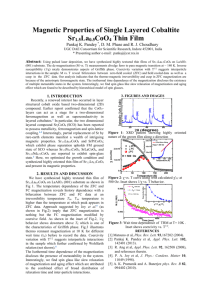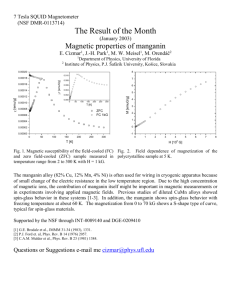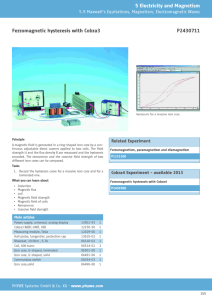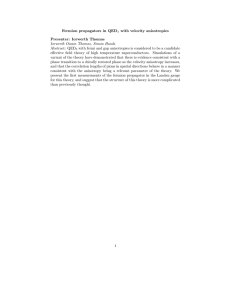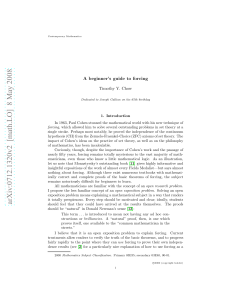Thermomagnetic hysteresis effects in NiMn and NiMnPd thin films ¨ ner
advertisement
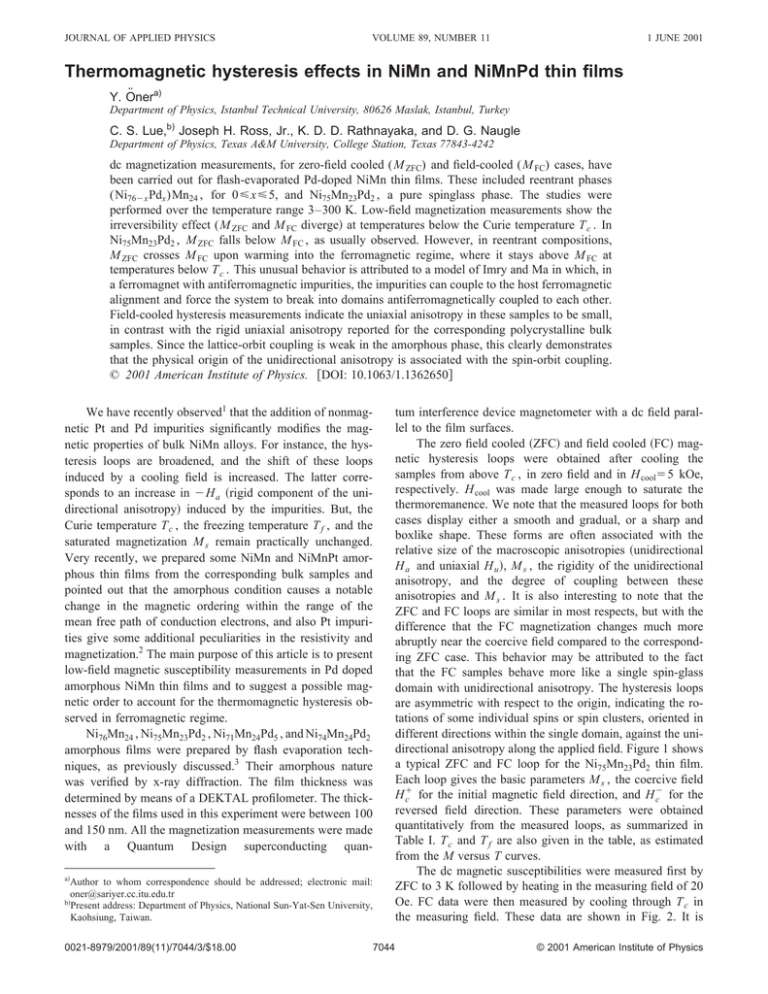
JOURNAL OF APPLIED PHYSICS VOLUME 89, NUMBER 11 1 JUNE 2001 Thermomagnetic hysteresis effects in NiMn and NiMnPd thin films Y. Önera) Department of Physics, Istanbul Technical University, 80626 Maslak, Istanbul, Turkey C. S. Lue,b) Joseph H. Ross, Jr., K. D. D. Rathnayaka, and D. G. Naugle Department of Physics, Texas A&M University, College Station, Texas 77843-4242 dc magnetization measurements, for zero-field cooled (M ZFC) and field-cooled (M FC) cases, have been carried out for flash-evaporated Pd-doped NiMn thin films. These included reentrant phases (Ni76⫺x Pdx )Mn24 , for 0⭐x⭐5, and Ni75Mn23Pd2 , a pure spinglass phase. The studies were performed over the temperature range 3–300 K. Low-field magnetization measurements show the irreversibility effect (M ZFC and M FC diverge兲 at temperatures below the Curie temperature T c . In Ni75Mn23Pd2 , M ZFC falls below M FC , as usually observed. However, in reentrant compositions, M ZFC crosses M FC upon warming into the ferromagnetic regime, where it stays above M FC at temperatures below T c . This unusual behavior is attributed to a model of Imry and Ma in which, in a ferromagnet with antiferromagnetic impurities, the impurities can couple to the host ferromagnetic alignment and force the system to break into domains antiferromagnetically coupled to each other. Field-cooled hysteresis measurements indicate the uniaxial anisotropy in these samples to be small, in contrast with the rigid uniaxial anisotropy reported for the corresponding polycrystalline bulk samples. Since the lattice-orbit coupling is weak in the amorphous phase, this clearly demonstrates that the physical origin of the unidirectional anisotropy is associated with the spin-orbit coupling. © 2001 American Institute of Physics. 关DOI: 10.1063/1.1362650兴 We have recently observed1 that the addition of nonmagnetic Pt and Pd impurities significantly modifies the magnetic properties of bulk NiMn alloys. For instance, the hysteresis loops are broadened, and the shift of these loops induced by a cooling field is increased. The latter corresponds to an increase in ⫺H a 共rigid component of the unidirectional anisotropy兲 induced by the impurities. But, the Curie temperature T c , the freezing temperature T f , and the saturated magnetization M s remain practically unchanged. Very recently, we prepared some NiMn and NiMnPt amorphous thin films from the corresponding bulk samples and pointed out that the amorphous condition causes a notable change in the magnetic ordering within the range of the mean free path of conduction electrons, and also Pt impurities give some additional peculiarities in the resistivity and magnetization.2 The main purpose of this article is to present low-field magnetic susceptibility measurements in Pd doped amorphous NiMn thin films and to suggest a possible magnetic order to account for the thermomagnetic hysteresis observed in ferromagnetic regime. Ni76Mn24 , Ni75Mn23Pd2 , Ni71Mn24Pd5 , and Ni74Mn24Pd2 amorphous films were prepared by flash evaporation techniques, as previously discussed.3 Their amorphous nature was verified by x-ray diffraction. The film thickness was determined by means of a DEKTAL profilometer. The thicknesses of the films used in this experiment were between 100 and 150 nm. All the magnetization measurements were made with a Quantum Design superconducting quan- tum interference device magnetometer with a dc field parallel to the film surfaces. The zero field cooled 共ZFC兲 and field cooled 共FC兲 magnetic hysteresis loops were obtained after cooling the samples from above T c , in zero field and in H cool⫽5 kOe, respectively. H cool was made large enough to saturate the thermoremanence. We note that the measured loops for both cases display either a smooth and gradual, or a sharp and boxlike shape. These forms are often associated with the relative size of the macroscopic anisotropies 共unidirectional H a and uniaxial H u 兲, M s , the rigidity of the unidirectional anisotropy, and the degree of coupling between these anisotropies and M s . It is also interesting to note that the ZFC and FC loops are similar in most respects, but with the difference that the FC magnetization changes much more abruptly near the coercive field compared to the corresponding ZFC case. This behavior may be attributed to the fact that the FC samples behave more like a single spin-glass domain with unidirectional anisotropy. The hysteresis loops are asymmetric with respect to the origin, indicating the rotations of some individual spins or spin clusters, oriented in different directions within the single domain, against the unidirectional anisotropy along the applied field. Figure 1 shows a typical ZFC and FC loop for the Ni75Mn23Pd2 thin film. Each loop gives the basic parameters M s , the coercive field ⫺ H⫹ c for the initial magnetic field direction, and H c for the reversed field direction. These parameters were obtained quantitatively from the measured loops, as summarized in Table I. T c and T f are also given in the table, as estimated from the M versus T curves. The dc magnetic susceptibilities were measured first by ZFC to 3 K followed by heating in the measuring field of 20 Oe. FC data were then measured by cooling through T c in the measuring field. These data are shown in Fig. 2. It is a兲 Author to whom correspondence should be addressed; electronic mail: oner@sariyer.cc.itu.edu.tr b兲 Present address: Department of Physics, National Sun-Yat-Sen University, Kaohsiung, Taiwan. 0021-8979/2001/89(11)/7044/3/$18.00 7044 © 2001 American Institute of Physics Öner et al. J. Appl. Phys., Vol. 89, No. 11, 1 June 2001 7045 FIG. 1. Magnetic hysteresis loop for the Ni75Mn23Pd2 film. Open and closed symbols are for FC and ZFC cases, respectively. clear from the figures that irreversibility effects persist up to T c , as evidenced by the splitting of FC and ZFC curves. In spinglass phases, M ZFC falls below M FC , as usually observed. However, in reentrant compositions, M ZFC crosses the M FC curve upon further warming into the ferromagnetic phases. Unlike the bulk samples mentioned above, not only the unidirectional anisotropy, but also the other parameters are affected by Pd impurities. The unidirectional anisotropy completely loses its rigidity for Ni71Mn24Pd5 and Ni75Mn23Pd2 thin films while, for the Ni74Mn24Pd2 and Ni76Mn24 thin films, the measured loop for the FC case is slightly displaced from the origin in the ⫺H direction, i.e., opposite to the cooling field direction. The amount of this displacement 共the negative value of the average coercive field兲 for the former film is found to be about 100 Oe, whereas this amount is about 500 Oe for the corresponding bulk sample.1 Similar behavior has been reported on NiMn films 共whether amorphous or not兲 by Hauser and Bernardini.4,5 They suggested that a displaced hysteresis loop is the result of a specific crystal structure and is not necessarily linked to the spin glass state. However, recent torque,6 ESR,7 and susceptibility8 experiments clearly demonstrated that the anisotropy observed in these systems is purely unidirectional and rotates elastically at lower temperatures, but dissipatively at higher temperatures, resulting in larger undisplaced hysteresis. Therefore, one can claim that in the case of breaking long range crystal order, owing to TABLE I. Parameters obtained from hysteresis loops at T⫽3 K after cooling in zero 共ZFC兲 and 5 kOe 共FC兲, and the Curie and freezing temperatures pertaining to these samples. H a is calculated from H c⫹ and H c⫺ . Upper and lower coercive field values shown correspond to the FC and ZFC cases, respectively. Sample M s 共emu/g兲 H c⫹ 共Oe兲 H c⫺ 共Oe兲 H a 共Oe兲 T c 共K兲 T f 共K兲 Ni76Mn24 40 Ni75Mn23Pd2 35 Ni74Mn24Pd2 ⬃2 Ni71Mn24Pd5 24 200 180 135 140 725 725 280 280 ⫺360 ⫺280 ⫺145 ⫺140 ⫺925 ⫺725 ⫺340 ⫺280 80 50 5 – 100 – 30 – 270 35 240 50 180 60 230 50 FIG. 2. M vs T of 共a兲 Ni76Mn24, 共b兲 Ni75Mn23Pd2, 共c兲 Ni74Mn24Pd2, and 共d兲 Ni71Mn24Pd5. Note that the onset of irreversibility occurred at temperatures just above the Curie point T c . Open symbols show data obtained while cooling in 20 Oe, while closed symbols correspond to the ZFC case. weak lattice-orbit coupling averaged over a whole sample, the unidirectional field becomes much more free to rotate along the applied field direction. Thus, we believe that the dynamic character of the unidirectional anisotropy depends on the local crystal structural order as being responsible for the hysteresis. On the other hand, and in contrast with previous observations on bulk NiMnPd alloys, a considerable reduction in M s is clearly seen in these data, with increasing Pd substitution up to 2 at.%. As the Pd content is further increased, Pd impurities favor magnetic order; T c and M s increase 共see Table I兲. Since a broadening of the magnetic hysteresis observed in these films has been attributed to the loss of the unidirectional anisotropy, few percent Pd impurities definitely enhance this anisotropy, whether or not the sample is polycrystalline. As for the irreversibility effect observed in M versus T, it is remarkable to note that this irreversibility appears at temperatures just below T c . The other, most striking feature of the M versus T curves is that, in the ferromagnetic phase, at temperatures below T c , M FC stays below M ZFC . Although many authors examined the weak and strong irreversibility effects observed at temperatures below T f , based on the models relying upon the freezing of the transverse spin components9 and the longitudinal spin components,10 respectively, most of them overlook the irreversibility observed at much higher temperatures than T f . At first sight, this irreversible effect seems to be a puzzle, however a model proposed by Imry and Ma11 may account for this experimental behavior. According to this model, in a classical ferromagnet with antiferromagnetic site impurities, a random component of the field due to such impurities can couple to the host ferromagnetic alignment and force the system to break into domains antiferromagnetically coupled to each other. As the sample passes through T c , either in FC or ZFC cases, the 7046 Öner et al. J. Appl. Phys., Vol. 89, No. 11, 1 June 2001 onset of long-range ferromagnetic ordering accompanied by antiparallel alignment of some spins at antiferromagnetic impurity sites may yield a decrease in the average moment per atom. Since the degree of antiferromagnetic alignment along the applied field for the FC case will be much higher than that for the ZFC case, it is reasonable to expect that M FC stays below M ZFC . As a conclusion, our experiment seems to favor the Imry–Ma model to account for this unusual irreversibility effect observed in the NiMn system. One of us 共Y.Ö.兲 gratefully acknowledges the support of a Fulbright Scholarship. This work was supported in part by the Robert A. Welch Foundation, Grant No. A-0514. 1 S. Hadjoudj, S. Senoussi, M. F. Mosbah, and Y. Öner, J. Magn. Magn. Mater. 175, 328 共1997兲. 2 Y. Öner, A. Kihç, and S. Senoussi, J. Phys.: Condens. Matter 9, 6689 共1997兲. 3 Y. Öner, A. Kihç, and H. Çelik, Physica B 215, 205 共1995兲. 4 J. J. Hauser and J. E. Bernardini, Phys. Rev. B 30, 3803 共1984兲. 5 J. J. Hauser, Phys. Rev. B 34, 3453 共1986兲. 6 Y. Öner and H. Sari, Phys. Rev. B 49, 5999 共1994兲. 7 Y. Öner, B. Aktaş, F. Apaydin, and E. A. Harris, Phys. Rev. B 37, 5866 共1988兲. 8 T. Sato, Phys. Rev. B 41, 2550 共1990兲. 9 M. Gabay and G. Toulouse, Phys. Rev. Lett. 47, 201 共1981兲. 10 J. R. L. De Almeida and D. J. Thouless, J. Phys. A 11, 983 共1978兲. 11 J. Imry and S.-K. Ma, Phys. Rev. Lett. 21, 1399 共1975兲.
